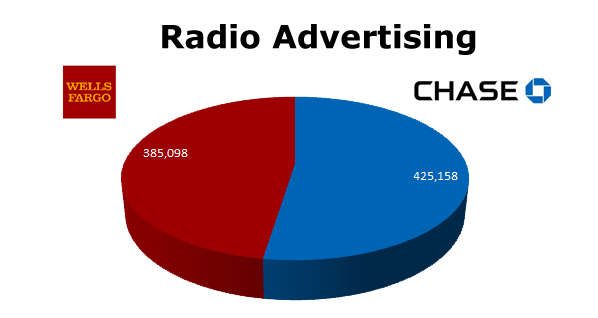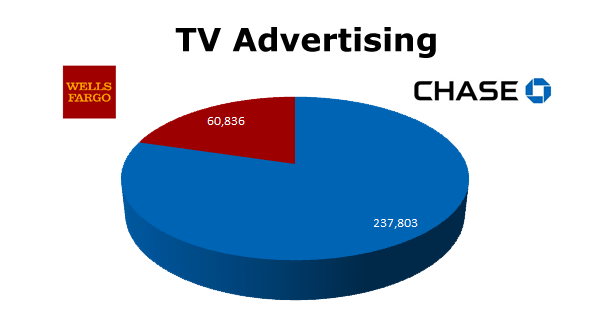


Click an icon to download Adobe Reader  or PDF Plugin for Firefox
or PDF Plugin for Firefox 

CITY FACTS
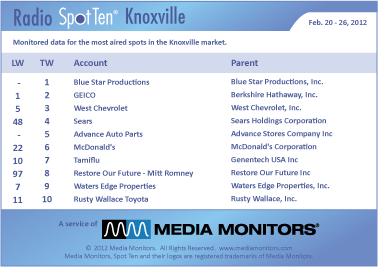 Last week in Knoxville the #1 radio advertiser was BLUE STAR PRODUCTIONS with 820 spots. GEICO came in #2 airing 400 announcements, while WEST CHEVROLET leaped into #3 with 299 spots. SEARS exploded from #48 to #4 with 202 commercials and ADVANCE AUTO PARTS parked at #5 with 194 spots. MCDONALD’S moved from #22 to #6 with 188 ads, while TAMIFLU flew into #7 with 186 spots. RESTORE OUR FUTURE (Pro-Mitt Romney PAC) forged into #8 with 184 spots and WATERS EDGE PROPERTIES took #9 with 177 ads. And in at #10 was RUSTY WALLACE TOYOTA with 175 spots.
Last week in Knoxville the #1 radio advertiser was BLUE STAR PRODUCTIONS with 820 spots. GEICO came in #2 airing 400 announcements, while WEST CHEVROLET leaped into #3 with 299 spots. SEARS exploded from #48 to #4 with 202 commercials and ADVANCE AUTO PARTS parked at #5 with 194 spots. MCDONALD’S moved from #22 to #6 with 188 ads, while TAMIFLU flew into #7 with 186 spots. RESTORE OUR FUTURE (Pro-Mitt Romney PAC) forged into #8 with 184 spots and WATERS EDGE PROPERTIES took #9 with 177 ads. And in at #10 was RUSTY WALLACE TOYOTA with 175 spots.
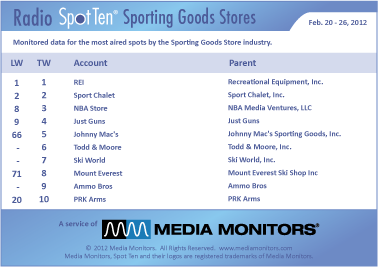 NATIONAL STATISTICS -
In the category of Sporting Goods, REI took the lead with 502 spots nationwide. SPORT CHALET came in #2 with 282 commercials, while NBA STORE bounced from #8 to #3 with 212 spots. JUST GUNS shot from #9 to #4 with 209 spots and JOHNNY MAC’S moved from #66 to #5 airing 205 spots. TODD & MOORE appears at #6 with 199 spots, while SKI WORLD shows at #7 running 175 spots. MOUNT EVEREST climbed from #71 to #8 with 171 spots and AMMO BROS comes in #9 with 137 ads. PPK ARMS reloads at #10 running 131 spots.
NATIONAL STATISTICS -
In the category of Sporting Goods, REI took the lead with 502 spots nationwide. SPORT CHALET came in #2 with 282 commercials, while NBA STORE bounced from #8 to #3 with 212 spots. JUST GUNS shot from #9 to #4 with 209 spots and JOHNNY MAC’S moved from #66 to #5 airing 205 spots. TODD & MOORE appears at #6 with 199 spots, while SKI WORLD shows at #7 running 175 spots. MOUNT EVEREST climbed from #71 to #8 with 171 spots and AMMO BROS comes in #9 with 137 ads. PPK ARMS reloads at #10 running 131 spots.
 NATIONAL STATISTICS -
On the national scene, GEICO maintains #1 with 51,034 spots. MCDONALD’S makes its move into #2 with 26,797 spots, while ADVANCE AUTO PARTS is back in the big time with 22,230 spots making them #3. STATE FARM was #4 airing 19,084 commercials and LOWE’S was #5 running 18,103 spots last week.
NATIONAL STATISTICS -
On the national scene, GEICO maintains #1 with 51,034 spots. MCDONALD’S makes its move into #2 with 26,797 spots, while ADVANCE AUTO PARTS is back in the big time with 22,230 spots making them #3. STATE FARM was #4 airing 19,084 commercials and LOWE’S was #5 running 18,103 spots last week.


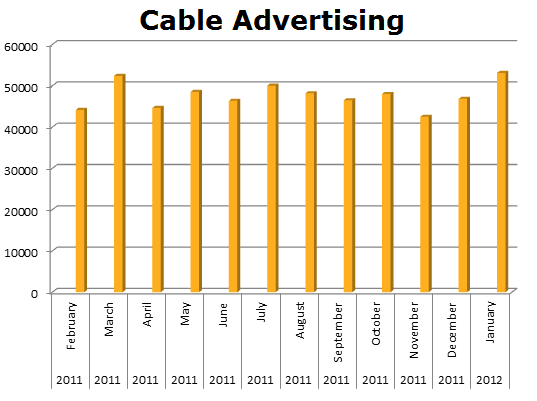 On Local Cable Cox Communications ran a total of 571,009 spots in the last 12 months. Their strongest month was January of 2012 with 53,078 and last March 2011 was also big with 52,385 ads. 53.54% of all their spots ran on Cable.
On Local Cable Cox Communications ran a total of 571,009 spots in the last 12 months. Their strongest month was January of 2012 with 53,078 and last March 2011 was also big with 52,385 ads. 53.54% of all their spots ran on Cable.
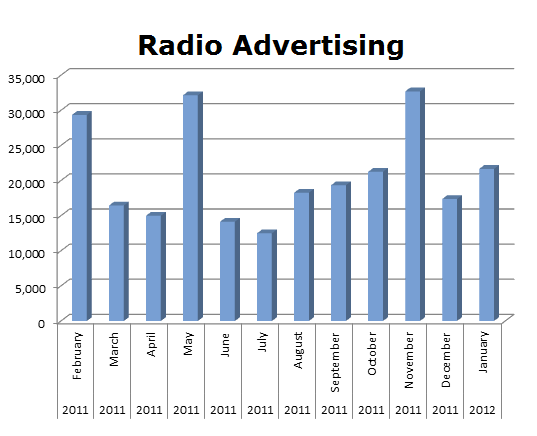 On the Radio, Cox Communications ran 250,207 spots in the last 12 months with last November being the biggest with 32,701 spots.
On the Radio, Cox Communications ran 250,207 spots in the last 12 months with last November being the biggest with 32,701 spots.
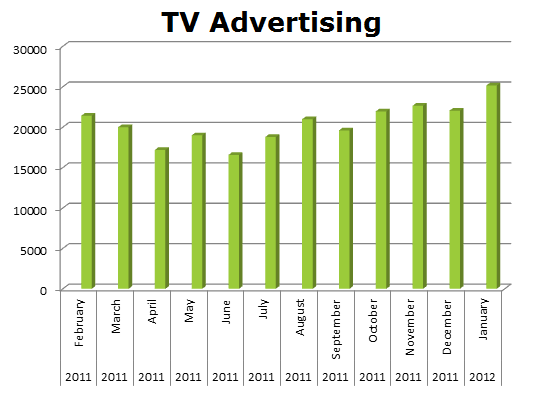 On TV, Cox ran 245,315 spots in the last month with the largest bundle delivered last month January with 53,078 spots.
On TV, Cox ran 245,315 spots in the last month with the largest bundle delivered last month January with 53,078 spots.
POSTED: February 27, 2012

Wells Fargo & Co. was founded in 1852 by Henry Wells and William Fargo. The new company offered banking (buying gold, and selling paper bank drafts as good as gold) - and express (rapid delivery of the gold and anything else valuable).
Wells Fargo opened for business in the gold rush port of San Francisco and soon had agents in the other cities and mining camps of the West.
By 1918, Wells Fargo was part of 10,000 communities across the country. That same year, the federal government took over the nation’s express network during the First World War, as part of the “war effort”, and Wells Fargo was left with just one bank in San Francisco.
Throughout the 20th Century, Wells Fargo rebuilt from just one office in San Francisco. And in the 1960s, Wells Fargo became a northern California regional bank with branch offices everywhere.
In the 1980s Wells Fargo expanded into a state-wide bank and became the seventh largest bank in the nation. It also launched an online service.
By the 1990s, Wells Fargo was back into their original areas throughout the Western, Midwestern and Eastern states. But it was the financial crisis of 2008 that gave Wells Fargo their biggest expansion plan.
In October of 2008, Wachovia agreed to be bought by Wells Fargo for about $14.8 billion in an all-stock transaction. Citigroup then announced that they would buy Wachovia for $2.1 billion. Citigroup protested Wachovia's agreement to sell itself to Wells Fargo and threatened legal action over the matter. However the deal with Wells Fargo overwhelmingly won shareholder approval since it valued Wachovia at about 7 times what Citigroup offered.
There were many court maneuvers and negotiations that ended in Wells Fargo winning the deal. But, they then got bail-out money from the government to make the deal work and they paid it back. As part of the redemption of the preferred stock, Wells Fargo also paid principal and accrued dividends of $131.9 million, bringing the total dividends paid to the U.S. Treasury and U.S. taxpayers to $1.441 billion.
Today, Wells Fargo has more than 10,000 bank branches and mortgage and consumer finance offices nationwide. They just went through the largest conversion of their Wachovia branches which now brings all 6,239 retail banking stores under one platform. They have 260,000 employees. According to their latest annual report they produced revenues of $87.60 billion with a net income of $15.87 billion.
JPMorgan Chase & Co. is one of the oldest financial services firms in the world. It has operations in 60 countries. It is a leader in financial services with assets of $2 trillion, and the largest market capitalization and third largest deposit base U.S. banking institution behind Wells Fargo and Bank of America.
The rich history of JP Morgan is amazing. JPMorgan Chase, its current structure, is the result of the combination of several large U.S. banking companies over the last decade including Chase Manhattan Bank, J.P. Morgan & Co., Bank One, Bear Stearns and Washington Mutual. Going back further, its predecessors include major banking firms among which are Chemical Bank, Manufacturers Hanover, First Chicago Bank, National Bank of Detroit, Texas Commerce Bank, Providian Financial and Great Western Bank.
The heritage of the House of Morgan traces its roots back to the partnership of Drexel, Morgan & Co. which in 1895, was renamed J.P. Morgan & Co. Arguably the most influential financial institutions of its era, J.P. Morgan & Co. financed the formation of the United States Steel Corporation, which took over the business of Andrew Carnegie and others and was the world's first billion-dollar corporation.
The Chase Manhattan Bank was formed upon the 1931 purchase of Chase National Bank (established in 1877) by the Bank of the Manhattan Company (established in 1799), the company's oldest predecessor institution. The Bank of the Manhattan Company was the creation of Aaron Burr, who transformed The Manhattan Company from a water carrier into a bank.
During the banking crisis and financial meltdown in 2008, JPMorgan Chase was in the middle of it with their purchase of Bear Stearns. The Federal Reserve Bank of New York provided an emergency loan to try to avert a sudden collapse of Bear Stearns. The company could not be saved and was sold to JP Morgan Chase for far below the perceived market value. The company no longer exists.
According to the latest annual report, JPMorgan Chase & Co. produced revenues of $110.84 billion with net income of $18.20 billion. They have more than 260,000 employees.
MEDIA USAGE

